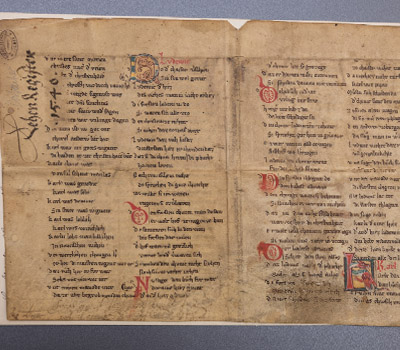Handschriftencensus (HSC). Kompetenzzentrum 'Deutschsprachige Handschriften des Mittelalters'
Links to the project
Written sources are – like art and buildings – integral parts of the cultural heritage, whose preservation, indexing and provision are central social duties. The knowledge of the past is principally based on texts, that more or less accidentally escaped destruction. These records preserve the knowledge, the faith, the tales, the visions and dreams of the people. They give testimony of past conceptions of order of life. They are a journal of cultural memory.
In the Middle Ages, texts were mostly written in Latin. But already in the Carolingian Era, but with a powerful dynamic only in the High Middle Ages, did the laymen discover the benefits of writing and books for themselves. One can fixate knowledge, can transport messages, contracts, legal acts, propaganda, but also “beautiful stories” over long distances and always be able to read and hear them again.
 Handschriftencensus (HSC). Kompetenzzentrum 'Deutschsprachige Handschriften des Mittelalters'
Handschriftencensus (HSC). Kompetenzzentrum 'Deutschsprachige Handschriften des Mittelalters'Handschriftencensus (HSC). Kompetenzzentrum 'Deutschsprachige Handschriften des Mittelalters'
Host Academy
Academy of Sciences and Literature, Mainz
Location and federal state
Marburg, Hesse
Type
Editions: Philosophy, History of Science, Linguistics and Literary Studies
Project number
II.B.63
The “Handschriftencensus” has the goal to record, to identify and to describe the thousands of vernacular books, that by now are dispersed around the world and which are admittedly often mere snippets and scraps. It therefore secures a significant part of our cultural heritage and simultaneously offers an important foundation for the understanding of the pre-modern era. On closing this project, all handwritten German textual evidence of the Middle Ages around the world will have been qualified and recorded using established methods. These manuscripts – that will be around 30.000 in the end- are scattered over more than 1.500 libraries, collections and archives, especially in Europe and North America. For most of the manuscripts and works, basic data must be collected first.
To be able to cope with the abundance of material, the work takes place in close consultation with national and international cooperation partners. The findings are made available in a freely accessible online database. An additional dynamic resource is the continuous updating and design of the data and the user interfaces as well as a diverse interlinking with additional relevant information. All this is indispensable, as the research of medieval texts and their handwritten carriers is in permanent flow. The “Handschriftencensus” is simultaneously a research instrument, a research platform, a standardisation entity and a clearing centre.
Back to overview
